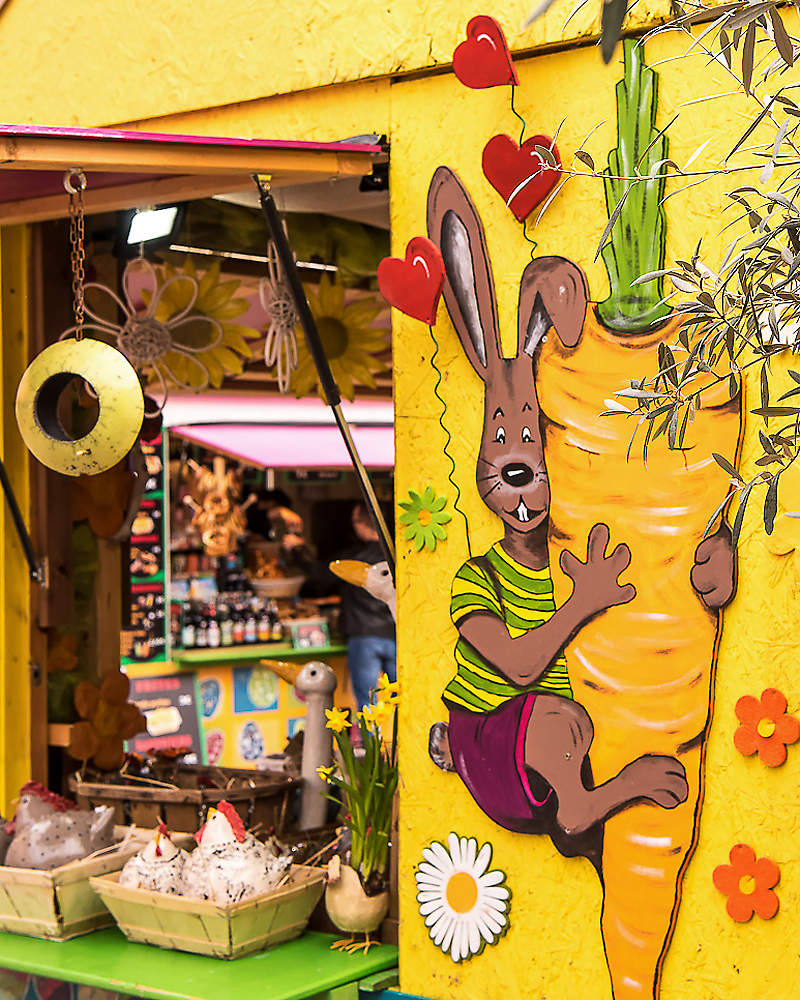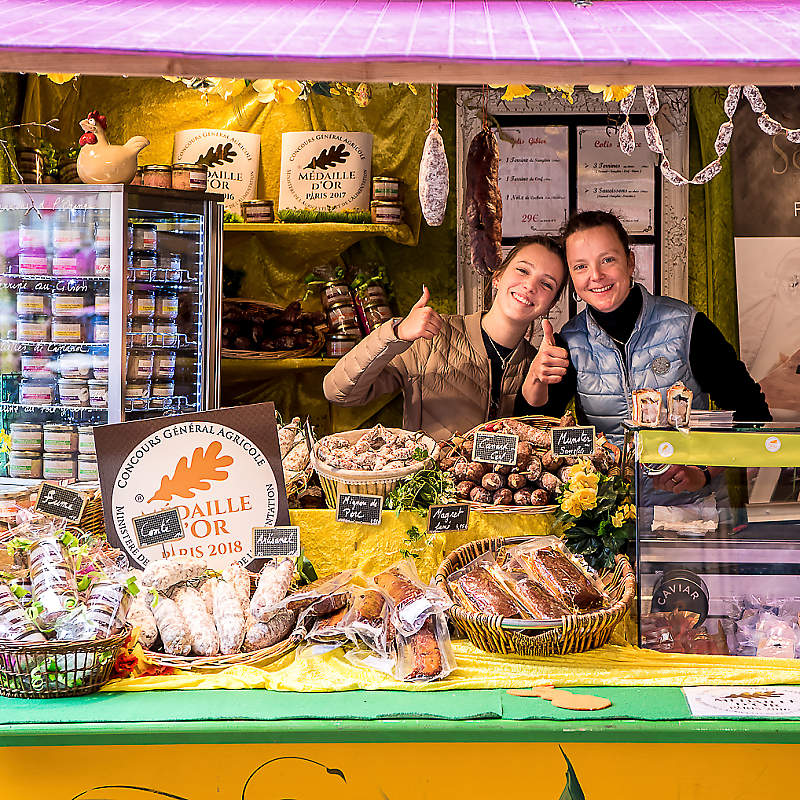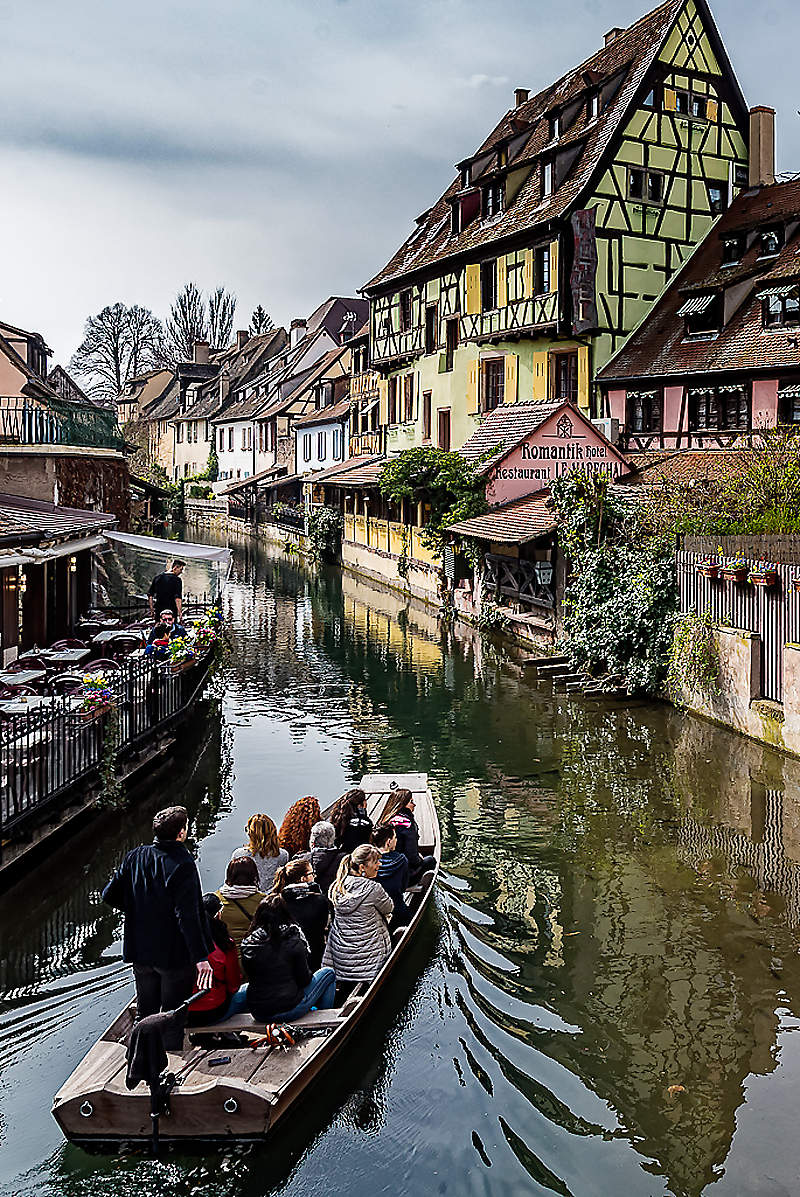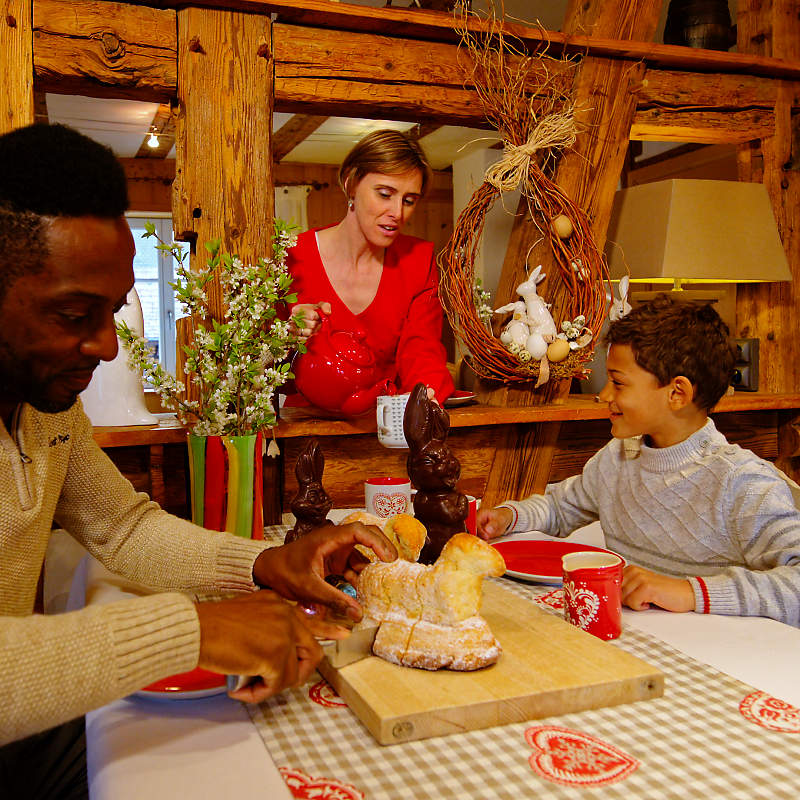Easter and its traditions in Riquewihr, Colmar & and in the heart of Alsace. The lamb (Lamala) and the Easter Hare (Oschterhaas).
To understand the meaning of the Alsatian traditions of Lamala and the Easter Hare, it is necessary to make a little reminder of History. Easter, for Christians, is the commemoration of the Resurrection of Jesus Christ.
Easter is the oldest Christian holiday. Attested since the 2nd century, the feast of Easter has its roots in the Jewish Passover (Pessa’h), which commemorates the exit from Egypt of the Hebrew people (see below). For Christians, who recognize in Jesus the Messiah, Easter commemorates his resurrection three days after the Last Supper (celebrated on Holy Thursday), the last meal he had with his disciples on the day of the Jewish Passover, the day before his Passion, according to the New Testament.
WHEN IS EASTER?
Easter is always a Sunday but the date changes every year!
In 2024, Easter was March 31; in 2025, Easter will be April 20, 2025.
The date of Easter was set by the Council of Nicaea (in the year 325) for the first Sunday after the first full moon following March 21! That’s why the Easter date changes every year. Western Churches, which have adopted the Gregorian calendar, often celebrate Easter on a date different from that of the Orthodox Churches, which always refer to the Julian calendar. The delay can be up to five weeks depending on the year.
The Passover Is the solemn feast of the Jews celebrated each year in memory of their exit from Egypt, commemorating their liberation from slavery under the reign of the pharaohs.
Easter, is the solemn feast celebrated every year in memory of the resurrection of Jesus Christ, who offered himself as a sacrifice at the time of the Jewish Passover.

THE EASTER LAMB…
On the occasion of the feast of the Jewish Passover, the Easter lamb is eaten, of which, as reported in the Jewish and Christian Holy Scriptures, the blood had marked the doors of the houses to protect them from the last wound of Egypt according to which death should fall on all the firstborn of man and livestock.
The prophecies of Isaiah and Jeremiah had announced the coming of a servant of God, “sweet as the lamb”. Then, Saint John the Baptist designated Jesus as “the Lamb of God who takes away the sin of the world”.
The Crucifixion of Jesus took place at this time of the Jewish Passover (therefore without “s”). On the occasion of this feast, the Jews sacrificed thousands of lambs. When on the eve of his death, during the last meal with his disciples, Jesus gave them a cup of wine by telling them: “This is my blood shed for the forgiveness of sins”, his disciples understood that he presented himself as “the Lamb of God”.

In heraldic art (the coats of arms), the Lamb is the symbol of sweetness, candor, innocence, kindness, frankness.
He is always represented in profile and often nimbé. Since the Middle Ages, the Easter lamb has been represented carrying a standard in one of its front legs: the banner of Christ.
Want to enjoy a succulent Lamala for breakfast?

THE LAMALA, A VERY OLD TRADITION…
La tradition typiquement alsacienne du Lammele est mentionnée dans une lettre du théologien catholique Thomas Murner, en 1519. A cette lointaine époque, le fiancé offrait un agneau pascal à sa fiancée. On l’offrait aussi aux enfants au retour de la messe du jour de Pâques. Pendant le carême, dans les familles catholiques, il était interdit de manger des œufs. Si bien que les œufs pondus pendant le carême s’accummulaient. Le Lammele, un biscuit riche en œufs, permettait donc d’écouler le stock accumulé avant Pâques. L’agneau, saupoudré de sucre glace, était décoré d’un étendard en papier de soie aux couleurs du Vatican (jaune et blanc) ou de l’Alsace (rouge et blanc).
WHO PREPARES THE LAMALA,
In the past, Lammele were also often made at home. In all the kitchens, there were therefore these terracotta molds that were used once a year. And a number were needed because moms and dads were several times godmother or godfather and their many godchildren also came to pick up their Lammele on Easter Day. Nowadays, lammelas are found in bakeries long before and after Easter, to the delight of gourmets.
THE LAMALAS OF THIERRY IN RIQUEWIHR,
A MUST TO TASTE!
Lammele is traditionally cooked in a glazed terracotta mold that retains a delicate cake scent for a long time after baking.
The dough is very fluid, and since the earthen molds were in two halves, they had to be joined with a wire staple so that the joint was as waterproof as possible.
In my little video, Thierry, the baker-pastry chef of Riquewihr, gives you a demonstration of the traditional preparation of lamalas in old mussels. Do not miss to taste your lammelas (at Kouglof & Cie, rue de la Couronne in Riquewihr), they are really exquisite!
To eat your Lammele, there is a ceremonial: with a sharp knife you cut the lammele with a lot of delicacy into thick slices, always starting from the back. A good smell of fresh biscuit is spreading. The lammele was tasted by the grown-ups accompanied by a glass of Alsace wine, while the children dipped it in a large bowl of chocolate or chicory for breakfast.
The lammalas are, with the Kougelhopf, the Maenella of Saint-Nicholas and the Christmas Bredele, traditional cakes still widely tasted in the Alsace region.
Want to enjoy a succulent Lamala for breakfast?
VIDEO
Experience the atmosphere of EASTER in one of our charming holiday homes in the ramparts of Riquewihr!
From the beginning of spring, Riquewihr awakens to the rebirth of nature and celebrates Easter.
In the streets and in our cottages, the Easter hare is omnipresent! Our cottages are among the best holiday accommodation in Alsace.
Choose yours and be welcome!

THE EASTER HARE, AN EMBLEMATIC ANIMAL IN ALSACE
Almost 20 centuries ago, in Europe, the Saxons used to celebrate fertility, symbolized by the goddess Eastre, whose sacred animal was a hare. The hare is often associated with goddesses of the moon; the egg and the hare (the female) together represent the god and the goddess, respectively.
Pagan fertility festivals at the time of the spring equinox were frequent. It was believed that at this time of year, male and female energies were balanced.
Later, the Christian church absorbed these pagan practices.
Experience the atmosphere of EASTER in one of our charming cottages in the Riquewihr Remparts!
WHY DOES THE EASTER HARE BRING EGGS?
Long before the Middle Ages there was a tradition – in Alsace and in the neighboring regions east of the Rhine – of an Easter hare that brought decorated eggs…
This can be explained by the 40-day Christian Lent, during which it was once forbidden to eat eggs, in the same way as other animal products such as meat, milk, butter and cheese. Of course, the chickens continued to lay eggs during this period. We had to find something to do with these many eggs that could not be eaten during Lent. To preserve them, the eggs were boiled and the shell was dyed so that they could be distinguished from raw eggs. The blossoming of many flowers in the spring also made it possible to boil eggs with flowers to change their color and bring spring to houses.

THE EASTER HARE,
A very old custom in Alsace…
The Easter hare was first mentioned in a book by Professor Georg Franck de Frankenau in 1682. Georg Franck studied medicine and anatomy in Strasbourg where he obtained his doctorate in medicine in 1666. In his medical treatise on Easter eggs “De ovis paschalibus”, he refers to a tradition – in Alsace and neighboring regions – of an Easter hare bringing eggs to Easter. In his book, as a doctor, he describes the harmful health consequences of excessive consumption of these eggs 🙂!!!

RIQUEWIHR AT THE EASTER SEASON
A colorful atmosphere is set in the main street of Riquewihr, one of the most beautiful villages in France.
Riquewihr is a wonderful and romantic small medieval town hidden at the foot of the Vosges mountains in the heart of the most famous vineyards of Alsace. Riquewihr is only 15 kilometers from Colmar and a few minutes from other famous Alsatian villages such as Ribeauvillé, Hunawihr, Eguisheim or Kaysersberg. Germany is less than an hour’s drive away. In short, Riquewihr is an ideal place to stay and to discover the entire region.
WELL-DECORATED STREETS…
In the main street of Riquewihr, the chairs and tables are back in the streets in front of the restaurants as soon as the sun shines.
The flowers are again available in the outdoor markets and tint the windows with colorful spots as Easter approaches.
Many houses decorate their facade with colorful eggs and hares in funny outfits.


YOUR STAY IN RIQUEWIHR
Experience the atmosphere of EASTER in one of our charming cottages in the Riquewihr Remparts!

COLMAR & ITS EASTER & SPRING MARKET
For a dozen years, Colmar has been celebrating Easter and Spring with a friendly market that is held for 3 weeks. This year, it takes place from March 28 to April 21, 2024. Certainly, the Colmar Spring market is smaller than its oldest, the very famous Christmas market. But you will be delighted to stroll from cottage to chalet, around the Church of the Dominicans and the Koïfhus (the Place de l’Ancienne Douane).
During these three weeks, the historic heart of the city is brightened by the fresh colors of Easter and Spring: the Easter Hare is everywhere, rabbits too, chickens and multicolored eggs. Of course, winter is well over!
The chalets in spring colors welcome 70 exhibitors from the region, rigorously selected. Of course, your delicacy will hardly resist it: Alsatian beer, chocolates, nougats, white wine from Alsace, macaroons, jams… But you will also find linen, decorative objects, plants, beauty products, clothes, jewelry, toys…


THE DATES FOR 2024
The Easter and Spring market in Colmar opens its doors in 2024, every day, from March 28 to April 21, 2024, from 10:00 a.m. to 7:00 p.m.
From time to time, a street concert will make you raise your ear. And, quite unknown, there are several independent winemakers in Colmar itself. They are waiting for you for nice commented tastings…
For the record, in 2025, Easter will be April 20.
VIDEO
An escape to the EASTER market in Colmar, only a few kilometers from our gîtes in Riquewihr!
From the beginning of spring, Alsace awakens to the rebirth of nature and celebrates Easter. In the streets, the Easter hare is omnipresent! A few kilometers from Colmar, our places to stay are among the best holiday accommodation in Alsace.
Choose yours and be welcome!


